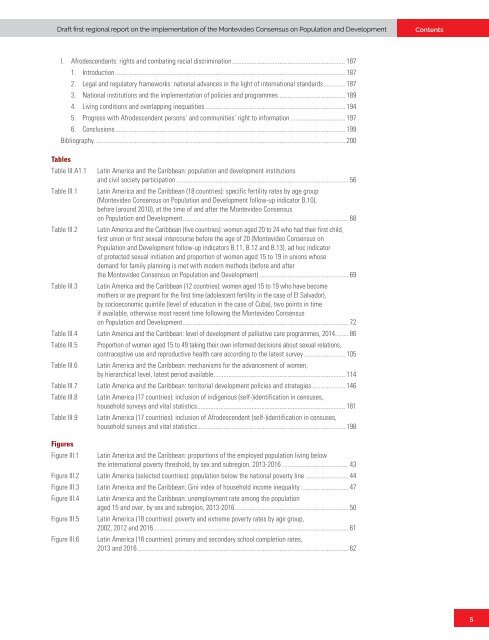Draft first regional report on the implementation of the Montevideo Consensus on Population and Development
This draft report seeks to give an account of progress in the implementation of the priority measures of the Montevideo Consensus on Population and Development in the region, as well as the differences between countries in terms of the degree of implementation. By highlighting relevant national experiences, it also seeks to facilitate the exchange of good practices among countries so that they can benefit from each other in their efforts to advance the implementation of the actions of the Montevideo Consensus.
This draft report seeks to give an account of progress in the implementation of the priority measures of the Montevideo Consensus on Population and Development in the region, as well as the differences between countries in terms of the degree of implementation. By highlighting relevant national experiences, it also seeks to facilitate the exchange of good practices among countries so that they can benefit from each other in their efforts to advance the implementation of the actions of the Montevideo Consensus.
You also want an ePaper? Increase the reach of your titles
YUMPU automatically turns print PDFs into web optimized ePapers that Google loves.
<str<strong>on</strong>g>Draft</str<strong>on</strong>g> <str<strong>on</strong>g>first</str<strong>on</strong>g> <str<strong>on</strong>g>regi<strong>on</strong>al</str<strong>on</strong>g> <str<strong>on</strong>g>report</str<strong>on</strong>g> <strong>on</strong> <strong>the</strong> implementati<strong>on</strong> <strong>of</strong> <strong>the</strong> M<strong>on</strong>tevideo C<strong>on</strong>sensus <strong>on</strong> Populati<strong>on</strong> <strong>and</strong> <strong>Development</strong><br />
C<strong>on</strong>tents<br />
I. Afrodescendants: rights <strong>and</strong> combating racial discriminati<strong>on</strong>...................................................................... 187<br />
1. Introducti<strong>on</strong>............................................................................................................................................. 187<br />
2. Legal <strong>and</strong> regulatory frameworks: nati<strong>on</strong>al advances in <strong>the</strong> light <strong>of</strong> internati<strong>on</strong>al st<strong>and</strong>ards.............. 187<br />
3. Nati<strong>on</strong>al instituti<strong>on</strong>s <strong>and</strong> <strong>the</strong> implementati<strong>on</strong> <strong>of</strong> policies <strong>and</strong> programmes......................................... 189<br />
4. Living c<strong>on</strong>diti<strong>on</strong>s <strong>and</strong> overlapping inequalities...................................................................................... 194<br />
5. Progress with Afrodescendent pers<strong>on</strong>s’ <strong>and</strong> communities’ right to informati<strong>on</strong>.................................. 197<br />
6. C<strong>on</strong>clusi<strong>on</strong>s............................................................................................................................................. 199<br />
Bibliography.......................................................................................................................................................... 200<br />
Tables<br />
Table III.A1.1<br />
Table III.1<br />
Table III.2<br />
Table III.3<br />
Latin America <strong>and</strong> <strong>the</strong> Caribbean: populati<strong>on</strong> <strong>and</strong> development instituti<strong>on</strong>s<br />
<strong>and</strong> civil society participati<strong>on</strong>.......................................................................................................... 56<br />
Latin America <strong>and</strong> <strong>the</strong> Caribbean (18 countries): specific fertility rates by age group<br />
(M<strong>on</strong>tevideo C<strong>on</strong>sensus <strong>on</strong> Populati<strong>on</strong> <strong>and</strong> <strong>Development</strong> follow-up indicator B.10),<br />
before (around 2010), at <strong>the</strong> time <strong>of</strong> <strong>and</strong> after <strong>the</strong> M<strong>on</strong>tevideo C<strong>on</strong>sensus<br />
<strong>on</strong> Populati<strong>on</strong> <strong>and</strong> <strong>Development</strong>...................................................................................................... 68<br />
Latin America <strong>and</strong> <strong>the</strong> Caribbean (five countries): women aged 20 to 24 who had <strong>the</strong>ir <str<strong>on</strong>g>first</str<strong>on</strong>g> child,<br />
<str<strong>on</strong>g>first</str<strong>on</strong>g> uni<strong>on</strong> or <str<strong>on</strong>g>first</str<strong>on</strong>g> sexual intercourse before <strong>the</strong> age <strong>of</strong> 20 (M<strong>on</strong>tevideo C<strong>on</strong>sensus <strong>on</strong><br />
Populati<strong>on</strong> <strong>and</strong> <strong>Development</strong> follow-up indicators B.11, B.12 <strong>and</strong> B.13), ad hoc indicator<br />
<strong>of</strong> protected sexual initiati<strong>on</strong> <strong>and</strong> proporti<strong>on</strong> <strong>of</strong> women aged 15 to 19 in uni<strong>on</strong>s whose<br />
dem<strong>and</strong> for family planning is met with modern methods (before <strong>and</strong> after<br />
<strong>the</strong> M<strong>on</strong>tevideo C<strong>on</strong>sensus <strong>on</strong> Populati<strong>on</strong> <strong>and</strong> <strong>Development</strong>)....................................................... 69<br />
Latin America <strong>and</strong> <strong>the</strong> Caribbean (12 countries): women aged 15 to 19 who have become<br />
mo<strong>the</strong>rs or are pregnant for <strong>the</strong> <str<strong>on</strong>g>first</str<strong>on</strong>g> time (adolescent fertility in <strong>the</strong> case <strong>of</strong> El Salvador),<br />
by socioec<strong>on</strong>omic quintile (level <strong>of</strong> educati<strong>on</strong> in <strong>the</strong> case <strong>of</strong> Cuba), two points in time<br />
if available, o<strong>the</strong>rwise most recent time following <strong>the</strong> M<strong>on</strong>tevideo C<strong>on</strong>sensus<br />
<strong>on</strong> Populati<strong>on</strong> <strong>and</strong> <strong>Development</strong>...................................................................................................... 72<br />
Table III.4 Latin America <strong>and</strong> <strong>the</strong> Caribbean: level <strong>of</strong> development <strong>of</strong> palliative care programmes, 2014......... 86<br />
Table III.5 Proporti<strong>on</strong> <strong>of</strong> women aged 15 to 49 taking <strong>the</strong>ir own informed decisi<strong>on</strong>s about sexual relati<strong>on</strong>s,<br />
c<strong>on</strong>traceptive use <strong>and</strong> reproductive health care according to <strong>the</strong> latest survey.......................... 105<br />
Table III.6 Latin America <strong>and</strong> <strong>the</strong> Caribbean: mechanisms for <strong>the</strong> advancement <strong>of</strong> women,<br />
by hierarchical level, latest period available................................................................................. 114<br />
Table III.7 Latin America <strong>and</strong> <strong>the</strong> Caribbean: territorial development policies <strong>and</strong> strategies..................... 146<br />
Table III.8 Latin America (17 countries): inclusi<strong>on</strong> <strong>of</strong> indigenous (self-)identificati<strong>on</strong> in censuses,<br />
household surveys <strong>and</strong> vital statistics........................................................................................... 181<br />
Table III.9 Latin America (17 countries): inclusi<strong>on</strong> <strong>of</strong> Afrodescendent (self-)identificati<strong>on</strong> in censuses,<br />
household surveys <strong>and</strong> vital statistics........................................................................................... 198<br />
Figures<br />
Figure III.1<br />
Latin America <strong>and</strong> <strong>the</strong> Caribbean: proporti<strong>on</strong>s <strong>of</strong> <strong>the</strong> employed populati<strong>on</strong> living below<br />
<strong>the</strong> internati<strong>on</strong>al poverty threshold, by sex <strong>and</strong> subregi<strong>on</strong>, 2013-2016.......................................... 43<br />
Figure III.2 Latin America (selected countries): populati<strong>on</strong> below <strong>the</strong> nati<strong>on</strong>al poverty line........................... 44<br />
Figure III.3 Latin America <strong>and</strong> <strong>the</strong> Caribbean: Gini index <strong>of</strong> household income inequality.............................. 47<br />
Figure III.4 Latin America <strong>and</strong> <strong>the</strong> Caribbean: unemployment rate am<strong>on</strong>g <strong>the</strong> populati<strong>on</strong><br />
aged 15 <strong>and</strong> over, by sex <strong>and</strong> subregi<strong>on</strong>, 2013-2016...................................................................... 50<br />
Figure III.5 Latin America (18 countries): poverty <strong>and</strong> extreme poverty rates by age group,<br />
2002, 2012 <strong>and</strong> 2016....................................................................................................................... 61<br />
Figure III.6 Latin America (18 countries): primary <strong>and</strong> sec<strong>on</strong>dary school completi<strong>on</strong> rates,<br />
2013 <strong>and</strong> 2016................................................................................................................................. 62<br />
5


















